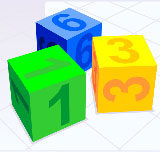1. Numerische Berechnungen
Aus Online Mathematik Brückenkurs 1
K (hat „1. Numerical calculations“ nach „1. Numerische Berechnungen“ verschoben: Page title translated) |
|||
| Zeile 50: | Zeile 50: | ||
<div class="inforuta" style="width: 580px;"> | <div class="inforuta" style="width: 580px;"> | ||
| - | ''' | + | '''Um den Abschnitt "Numerische Rechnungen" zu bestehen''' |
| - | + | ||
| - | + | ||
| - | + | ||
| - | + | ||
| - | + | ||
| - | + | ||
| - | + | ||
| - | + | # Lesen Sie zuerst den Theorieabschnitt und lesen Sie die Beispiele durch. | |
| + | # Lösen Sie danach die Übungen ohne Taschenrechner. Kontrollieren Sie Ihre Antworten indem Sie auf "Antwort" klicken. Falls Sie Hilfe brauchen können Sie auf "Lösung" klicken um mit Ihrer Lösung zu vergleichen. | ||
| + | # Wenn Sie mit den Übungen fertig sind können Sie die diagnostische Prüfung für das aktuelle Kapitel machen. | ||
| + | # Falls Sie irgendwelche Schwierigkeiten haben, können Sie im Forum nach ähnlichen Beiträgen suchen. Wenn Sie keinen hilfreichen Beitrag finden, können Sie selber eine Frage im Forum stellen, die ein Mentor (oder anderer Student) innerhalb von ein paar Stunden beantworten wird. | ||
| + | # Wenn Sie die diagnostische Prüfung bestanden haben, sollten Sie die Schlussprüfung machen. Um die Schlussprüfung zu bestehen, müssen Sie drei Fragen nach einander richtig beantworten. | ||
| + | # Wenn Sie die diagnostische Prüfung und die Schlussprüfung geschafft haben, haben Sie das Kapitel bestanden, und können mit dem nächsten Kapitel beginnen. | ||
| - | | + | P.S. Falls Sie mit dem Inhalt eines Kapitels schon sehr bekant sind, können Sie direkt die Prüfungen machen. Sie müssen auch dann alle Fragen richtig beantworten, aber Sie haben auch mehrere Versuche um die Prüfungen zu bestehen.</div> |
| - | + | ||
| - | + | ||
| - | + | ||
| - | + | ||
| - | </div> | + | |
Version vom 12:13, 8. Jan. 2009
| \displaystyle \text{@(a class="image" href="http://smaug.nti.se/temp/KTH/film3.html" target="_blank")@(img src="http://wiki.math.se/wikis/2008/forberedandematte1/img_auth.php/0/00/Lars_och_Elin.jpg" alt="Film om tal")@(/img)@(/a)} |
What is a number and who invented the four basic arithmetic operations?
Watch the video in which the lecturer Lasse Svensson tells us how arithmetic developed and answers Elins questions.
This first part of the course is about numerical calculations, that is, calculations with numbers. Another name for this is arithmetic.
Arithmetic is the study of the properties of numbers and the four basic operations: addition, subtraction, multiplication and division. We usually separate mathematics in different branches or areas, and arithmetic is one of those branches. Other branches are, for example, algebra, geometry and the theory of functions. The word arithmetic comes from the Greek "arithmos" meaning "number" and the ending -ic, means "knowledge". Thus the original meaning was "knowledge of numbers."
We begin with a discussion of various kinds of numbers and the usual basic operations. The numbers originated in measurements of various kinds (in the animal enclosure: 17 sheep, credit: -250 EURO, per guest: 1 / 8 cake, perimeter of the circle: 2 cm.).
The basic arithmetic operations are structured in a hierarchy that begins with addition and its opposite, subtraction. Following on from addition we have multiplication, which is addition repeated several times. The opposite operation to multiplication is division.
If one continues in the same way the next operation is exponentiation or raising to a power, which is a multiplication repeated several times. The reverse operation to this is to take the root of a number. Even logarithms can be regarded as a reverse operation to exponentiation. (This you can read about in Part 3 Roots and Logarithms.)

It is important to note that the material in this section — as well as in other parts of the course — is designed that one does not use calculators.
When you get to university, you will not be allowed to use calculators during your "exams", at least this is true for the basic courses. In advanced courses in mathematics one has hardly any use of calculators, as the mathematics is more about understanding principles than performing calculation. For example, it is more important to understand why 7 + 3 is the same as 3 + 7, than to be able to carry out the additions and obtain the answer 10.
Um den Abschnitt "Numerische Rechnungen" zu bestehen
- Lesen Sie zuerst den Theorieabschnitt und lesen Sie die Beispiele durch.
- Lösen Sie danach die Übungen ohne Taschenrechner. Kontrollieren Sie Ihre Antworten indem Sie auf "Antwort" klicken. Falls Sie Hilfe brauchen können Sie auf "Lösung" klicken um mit Ihrer Lösung zu vergleichen.
- Wenn Sie mit den Übungen fertig sind können Sie die diagnostische Prüfung für das aktuelle Kapitel machen.
- Falls Sie irgendwelche Schwierigkeiten haben, können Sie im Forum nach ähnlichen Beiträgen suchen. Wenn Sie keinen hilfreichen Beitrag finden, können Sie selber eine Frage im Forum stellen, die ein Mentor (oder anderer Student) innerhalb von ein paar Stunden beantworten wird.
- Wenn Sie die diagnostische Prüfung bestanden haben, sollten Sie die Schlussprüfung machen. Um die Schlussprüfung zu bestehen, müssen Sie drei Fragen nach einander richtig beantworten.
- Wenn Sie die diagnostische Prüfung und die Schlussprüfung geschafft haben, haben Sie das Kapitel bestanden, und können mit dem nächsten Kapitel beginnen.
